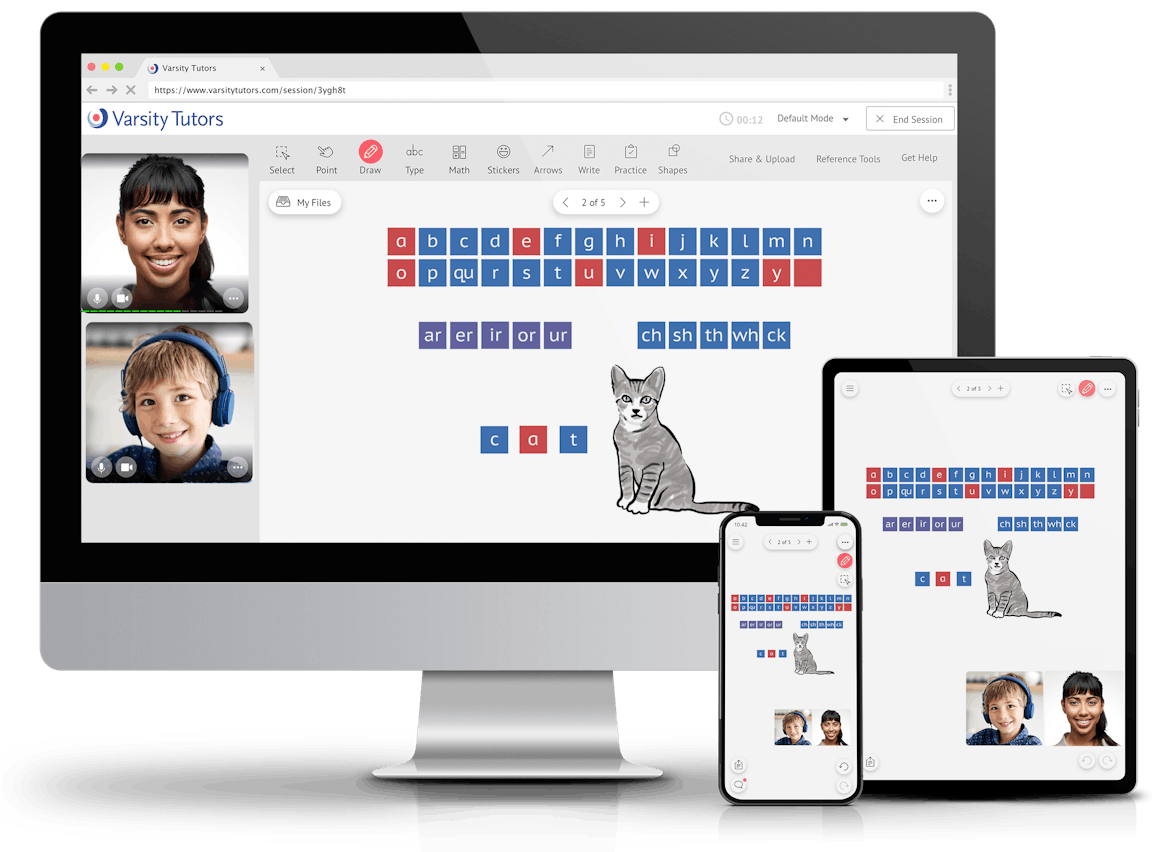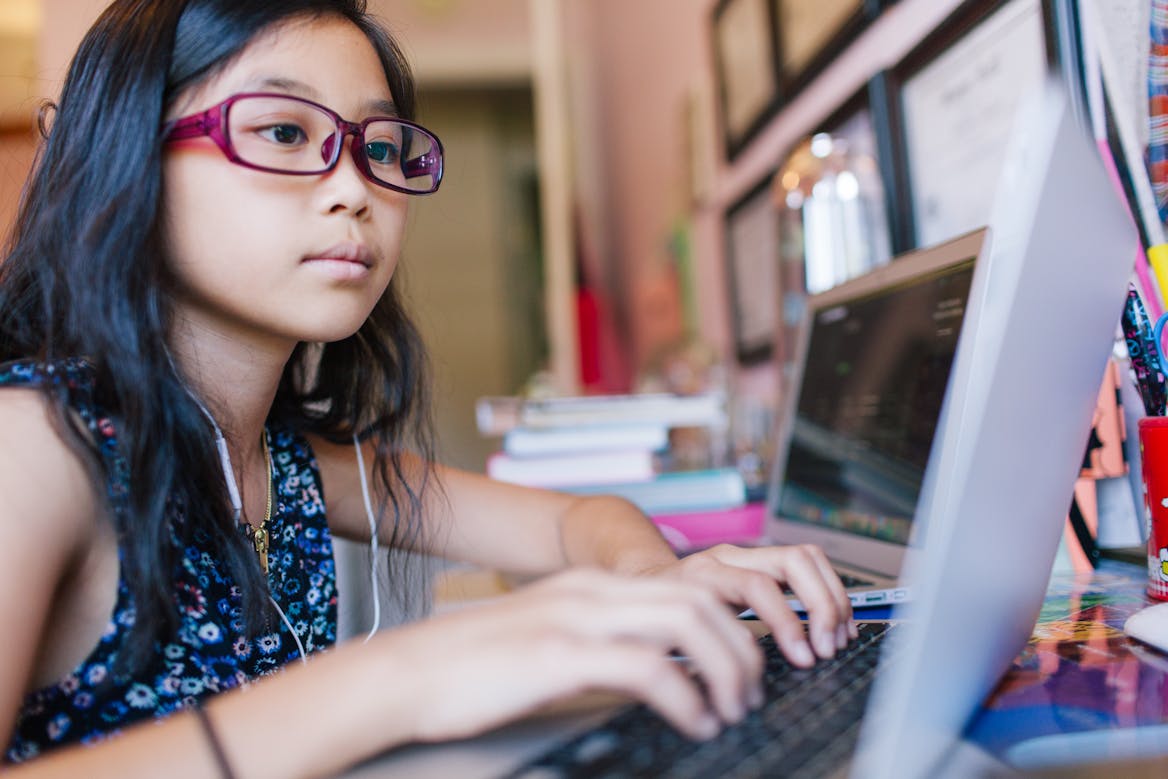
When you need help to overcome dyslexia, we’re here.
Find the support, advice, and resources to help your child with dyslexia succeed—in class, at home, and beyond.
At Varsity Tutors, your child’s success is our top priority. They deserve an education from people who “get them” and understand how dyslexia affects them. And you deserve a partner to help you navigate the unknowns of dyslexia. That’s where we come in.
Get dyslexia help from experienced tutors.
Making sure your child gets the right level of dyslexia help means matching them with a tutor who knows what they’re doing—someone who knows the given subject matter AND how to teach a child with dyslexia.
That’s why every tutor and instructor must go through an exhaustive vetting process that includes:
-
Completing in-depth interviews
-
Showing subject-specific knowledge in a simulated session
-
Demonstrating different teaching methods based on how different students learn
-
Proving their ability to educate virtually
-
Passing all academic and personal background checks
-
Completing a secondary review of certifications
-
Showing experience with IEPs or 504 plans
Let's find the exact right tutor for your child with dyslexia.
Your child is unique and they learn in their own unique way, dyslexic or not. So to find the right tutor for them, we start with a conversation about their needs and goals. With the insights you share, we factor in over 90 additional criteria to pinpoint the tutor or class that can make the biggest impact.
The Live Learning Platform
Dyslexia-help delivered in the right way.
Our innovative Live Learning Platform combines video, interactive tools, and collaborative workspaces to unlock new potential for students with dyslexia. With the proper setup (we recommend headphones and a quiet space), your child can stay more focused and may even feel like they’re sitting next to their tutor.

Meet with the right tutor, wherever they are.
The best tutor for your child is rarely in your neighborhood. With online tutoring on the Live Learning Platform, we can connect them to the best tutor for their needs regardless of geography.
Experience focused engagement.
By combining purpose-built tools with collaborative workspaces and 2-way video with their tutor, the platform helps your student stay focused on the task at hand.
Rewatch and relearn with recorded sessions.
Every tutoring session that happens on our platform is recorded. If your child can’t remember how a problem was solved or forgot a key piece of info, just rewind and rewatch.
Small Group Classes
Group learning for added confidence.
When a student begins to fall behind, they are often singled out for special help. Depending on the school size, they might be the only ones. They may feel isolated and get picked on. But they aren’t alone. With our Small Group Classes for dyslexia, we can put your child in a class with kids at the same level from across the country. As they learn alongside students with similar struggles from experienced instructors who know how to teach dyslexic students, you may be surprised by an increase in their confidence and academic performance.

Orton Gillingham Small Groups
Explore Classes

Executive Function Small Groups
Explore Classes

Special Education Math Collection
Explore Classes

Special Education Reading Comprehension Collection
Explore Classes

Getting a diagnosis.
School districts vary on how they help students who fall behind. Some districts do their own evaluations and place students on an IEP or 504 plan, which are essential for getting additional services.
If a school will not do an assessment, parents must find a 3rd-party organization to do an evaluation to get a diagnosis. (Note: Varsity Tutors does not offer evaluations or diagnoses.) It’s often best to start with your primary care physician to get recommendations for where to get an evaluation. The cost of the evaluation may or may not be covered by your health insurance provider. Once diagnosed, school districts are required to provide the additional services to help your child.
Advocating for your child with dyslexia.
As a parent, having a child who struggles with dyslexia is hard enough. When you layer on the complexities of the Special Education system, it can be overwhelming. But the more you understand what services your child needs, what they are entitled to from the school, and how to ask, the better off you’ll be.
Students diagnosed with learning differences like dyslexia are placed on either an Individualized Education Plan (IEP) or a 504 Plan.
Know their rights.
For additional insights and tips, watch this special presentation with author and special education law attorney, Pete Wright.
Visit our advocacy partner, WrightsLaw, to learn more about advocating for students with learning differences.

Find the right academic approach.
Once you understand the root cause or diagnosis of your student’s learning challenges, the next step is getting the right academic support. It’s important to note that if a school isn’t finding success with a typical approach, spending more time doing the same thing probably won’t change the outcome. In most cases, a child with dyslexia learns how to read using a structured, multi-sensory approach. Varsity Tutors offers Certified Reading Intervention by reading specialists who can provide these structured programs, along with Small Group Classes using the Orton Gillingham method.

Because confidence can go a long way.
When a child faces academic challenges due to dyslexia, they often suffer from a loss of confidence and lower self-esteem. Because their struggles are often surfaced in front of classmates, bullying can quickly become a serious problem. In the event your child experiences bullying, it’s important to address it. This could be as simple as acknowledging the problem and encouraging them to talk. Or it could be a reason to talk to a counselor.
All these factors can take their toll, to say the least. But this is where dyslexia help in the form of 1-on-1 Tutoring or a Small Group Class can really make a difference. Your child can work privately with an expert or they can learn alongside students just like them. As they see they aren’t alone and they have a safe place to work, their self-confidence improves right along with their reading ability.
Getting dyslexia help through technology.
Several new technologies have changed the way we learn and teach in countless ways. In fact, several of these developments have created opportunities to put new tools in the hands of students with dyslexia to help them with their academics.
Instant Tutoring is just one of the ways we can use technology to help your child. Whenever they get stuck on a problem or could use some quick help, they can connect with a tutor on our Live Learning Platform and get the answers or the help they need.
Be sure to check out these sites for more innovative solutions:
https://www.google.com/accessibility/
https://www.apple.com/accessibility/
https://www.microsoft.com/en-us/accessibility
And watch our inclusive and equitable education presentation with Microsoft


